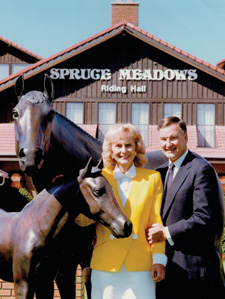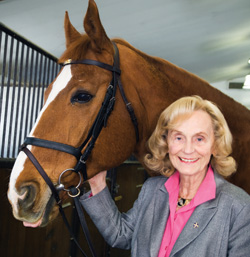In a city known for rodeos and big oil, two alumni have made Calgary's Spruce Meadows a premier destination for international show jumping.
A crowd several-thousand strong collectively holds its breath, as the horse and his rider clear one hurdle after another. On this sunny September day the grandstands are filled with a mixture of people: distinguished looking international visitors, amateur riders, young families - and even their dogs. They have all turned out for the last day of competition in the annual Spruce Meadows Master's Tourna-ment, one of the biggest days in international show jumping with over $1 million in prize money going to the world's top riders.
The size of the audience and the fact that a number of the weekend's top competitors are Canadian is a testament to the success of the sport in Canada - due, in no small part, to University of Alberta grads Ron, '53 BSc, '91 LLD (Honorary), and Marg Southern, '53 BPE, who opened Spruce Meadows in 1975
Understandably, when the Southerns first imagined Spruce Meadows, they didn't envision a world-class show-jumping venue. "We really just wanted to build a cinder-block stable that wouldn't burn down and a riding ring where the horses could jump," remembers Ron.
It was the early '70s and the couple's young daughters, Nancy and Linda, were both passionate about show jumping; however, Canadians interested in the sport had to travel to the East for most of their training and competition. Marg was finding it increasingly difficult to shuttle two daughters and their horses across the country, so when a fire burned down the stable where they boarded, it was the final straw, so to speak. In 1971, the couple purchased 80 acres about 20 minutes outside of Calgary's city limits from Mrs. Coppithorne. "She was a grand old Western lady," remembers Ron. "And she fixed me with her eyes and said, 'That'll be $2,000 an acre, Mr. Southern, and that's my price.'" Despite the incredible sum, he paid it. "Then a friend of mine said, 'Ron, if you're going to do that, make sure you don't just do it for your own girls but that you do it for everyone,'" he says. "I thought that was great advice." And so the seed of the idea for Spruce Meadows was planted.
Although his enterprises have always started small, Ron Southern has never been one to think small. Before he had even begun his studies at the U of A, he and his father had already founded a company - Alberta Trailer Hire - with a combined savings of $4,000, half of which Ron had earned working summers as a busboy, waiter and night porter at the Banff Springs Hotel. "We took that $4,000, and in 1947 we bought 10 little yellow trailers, which we rented out at service stations for $2 a day," he remembers. "We were going to call it Ron's Trailer Hire, but my dad said we should have a bigger view of things."
While completing his undergraduate studies at the U of A - switching majors several times from liberal arts to engineering to medicine - Ron continued to grow the business, first from renting trailers to selling trailers, then ultimately expanding into logistics, manufacturing and utilities. "Given the number of things I've been involved with, I couldn't have had a better education," he observes. Today, Alberta Trailer Company, or ATCO, as it is now called, is a publically traded company with 8,000 employees around the world and revenue of more than $3 billion a year.
Like ATCO, Spruce Meadows has had "a bigger view of things" since its earliest days.
In fact, the very first competition held at Spruce Meadows in the summer of 1976 was optimistically named the "Spruce Meadows International," although the 1,200 spectators who attended were mostly from Canada and came more out of curiosity than anything else. However, the Southerns knew that in order to make their venue truly international, they needed to attract the world's top talent to the "remote" foothills of western Canada. And to do that they needed to offer the highest-quality facilities and the biggest cash prizes.
In its first tournament season, Spruce Meadows offered $10,000 in prize money and its facilities consisted of stables and two meadows for tournaments. Today, thanks to the support of more than 100 corporate sponsors, it awards $5 million a year, and incorporates six different tournament rings, year-round facilities for events and concessions, and stables for up to 1,000 horses.
As accomplished varsity athletes (and 2006 Canadian Sports Hall of Fame inductees), the Southerns knew that in order for show jumping to appeal to a broad audience they needed to push it out of the society pages and into the sports section. And one of the secrets to their success in making names like Ian Millar and Big Ben household names was their early adoption and dominance in the emerging field of sports television.
In the early '70s, sports television consisted of about three hours a week of programming: including Hockey Night in Canada and the Wide World of Sports. Nonetheless, the Southerns made sure there was television coverage of their very first tournament. Today, Spruce Meadows houses its own in-house television production company, which produces more hours of international television broadcast to 108 countries than any other venue in Canada - and it's all footage of show jumping.
"One of the things the Southerns recognized from the very beginning was if Spruce Meadows was going to be more than a regional or local event, television was going to be a big part of it," says Ian Allison, '83 BA, senior vice-president for media, who is perhaps better known as the face and voice of Spruce Meadows on television.
Allison began working in the stables at Spruce Meadows during that first 1975 season, when he was just 16, and has been announcing the tournaments since 1978, when the regular announcer became unavailable because of a scheduling conflict with the Calgary Stampede. "Now, when I travel abroad, I have people say, 'Oh, I watch you every Tuesday night,'" says Allison. "Who would have thought that more people see international show jumping in a year than see CFL football or the Stampede rodeo and chuckwagon races?"
"We never expected it to be as large as it is right now or as world-renowned," says Marg, with characteristic understatement, "but we set out with three objectives when we first started Spruce Meadows: we wanted a place where young riders could train, we wanted a breeding program, and we wanted to put on show-jumping competitions. And we've never gotten away from those objectives."
In each of those three areas, Spruce Meadows has become a world leader. Here, junior riders warm up in the practice ring alongside the biggest names in the sport - Ian Millar, Beezie Madden and Eric Lamaze, just to name a few. Students from as far away as Germany come to apprentice themselves to head trainer Albert Kley.
In addition, the Southerns have grown a respected breeding program, helping to introduce the Hannoverian breed of horse to North American show jumping. Today, one of the most popular events at Spruce Meadows is the "Name the Foal" contest, in which members of the public can enter to win naming rights to some of the six or seven Hannoverian foals born there every spring.
But the central focus of Spruce Meadows has always been its tournaments. "We're a professional sports franchise without a team, like a Wimbledon or an Augusta," says Allison. "Often sports gets plagued by a numbing sameness, but Spruce Meadows has character. We like tradition here, but it's tradition tempered with innovation. Under the turf out there is one of the most sophisticated drainage and footing systems in the world, because that's where our athletes compete."
There are 16 tournaments held on the grounds every year from February to November, drawing an estimated 5,000 competitors and their crews to Calgary. Another 500,000 people turn out to watch them, and admission has always stayed just five dollars. Some tournaments are even free, making Spruce Meadows perhaps the only self-sustaining sports venue with an international reputation not to charge a hefty admission.
What's seen it through the years has been a combination of Ron's vision and Marg's determination. "Ron's always been a dreamer," says Marg. "He's got a great ability to see new ways of doing things, to say 'Yes, we've gone this far, but here's how we could go further.'"
For her part, Marg has been the doer, coming into the office every morning at 8:30 and staying until 6:00 or 7:00 at night to oversee the building of buildings, the relationships with sponsors and the general day-to-day operations of an organization that now includes 87 full-time employees (and up to 2,000 additional workers during the height of the tournament season).
"I'm the hands-on person who gets things done," she says. "I've become good at hiring people and managing construction. If I look at the new rings and grandstands we've built, it's been Ron's idea to get it done and my determination to see that it's done right."
It's an incredible partnership that began more than 60 years ago at Calgary's Crescent Heights High School, when a young Marg caught Ron's eye one day while playing on the girls' basketball team. Now, that partnership has been extended to a second generation. The couple's younger daughter, Linda Southern Heathcott, took over the mantle as president and CEO of Spruce Meadows in 2006. Linda was a champion show jumper herself and competed on the Canadian team in the 1996 Summer Olympic Games in Atlanta. And their older daughter, Nancy Southern, became president and CEO of the other family business - ATCO - in 2003, with her father remaining chairman of the board.
There's also a third generation that has taken up the reins of the family passion for horseback riding. Ben Asselin, the 16-year-old son of Nancy Southern and her husband, two-time Olympic rider John Asselin, made a stunning show on last year's junior circuit, winning two gold medals at the North American Junior and Young Riders' Championships in Kentucky.
But as the Southerns themselves will tell you, anything worth doing is worth doing well - and will take time to mature. Like good show-jumping horses, who don't hit their stride until they are 9-to-12 years old, good riders don't reach their prime until they are in their 30s. "Our sport is interesting," muses Marg. "There has never been anyone under 30 who has won an individual Olympic gold medal. It's wonderful in the sense that you can ride for so long, when in other sports you are finished when you're 16 or 17." Some riders, like Canada's Ian Millar, are still going strong at 64. And for international show-jumping visionaries? The lucky ones, like Ron and Marg Southern, are still in peak performance at 80.






We at New Trail welcome your comments. Robust debate and criticism are encouraged, provided it is respectful. We reserve the right to reject comments, images or links that attack ethnicity, nationality, religion, gender or sexual orientation; that include offensive language, threats, spam; are fraudulent or defamatory; infringe on copyright or trademarks; and that just generally aren’t very nice. Discussion is monitored and violation of these guidelines will result in comments being disabled.